Forecasting Model for Danube River Water Temperature Using Artificial Neural Networks
Abstract
1. Introduction
2. Materials and Methods
2.1. Study Area and Hydrometeorological Data
- Baziaș (rkm 1072)–Drobeta Turnu Severin (rkm 931);
- Iron Gate II (rkm 863)–Călărași (rkm 370);
- Călărași–Ceatal Ismail (delta apex at rkm 80);
- Ceatal Ismail–Black Sea.
2.2. Air and Water Data
2.3. ANN Arhitecture
2.4. ANN Danube Water Temperature Prediction Model at Chiciu–Călărași
2.5. Input Data for the ANN Model
2.6. Simple Statistical Models for Danube River Temperature Prediction
2.6.1. Statistical Model 1
2.6.2. Statistical Model 2
2.6.3. Statistical Model 3
2.6.4. Statistical Model 4
2.7. Evaluation Metrics
- The correlation coefficient (R):
- The root mean square error (RMSE),representing the standard deviation of the predicted value;
- The root mean square error corresponding to a confidence level of 95% (RMSE 95%):
3. Results and Discussion
3.1. Results of the Training Stage of the ANN Danube Water Temperature Model at Chiciu–Călărași
3.2. Results of the Testing Stage of the ANN Danube Water Temperature Model at Chiciu–Călărași
3.3. Comparison of the Testing Stage of the ANN Danube Water Temperature Model with Simple Statistical Models
4. Conclusions
Author Contributions
Funding
Data Availability Statement
Conflicts of Interest
References
- Caissie, D. The thermal regime of rivers: A review. Freshw. Biol. 2006, 51, 1389–1406. [Google Scholar] [CrossRef]
- Stephen, J.D.; David, M.H.; Iain, A.M. River temperature modelling: A review of process-based approaches and future directions. Earth-Sci. Rev. 2017, 175, 97–113. [Google Scholar]
- IPCC. Climate Change 2023: Synthesis Report. Contribution of Working Groups I, II and III to the Sixth Assessment Report of the Intergovernmental Panel on Climate Change; Core Writing Team, Lee, H., Romero, J., Eds.; IPCC: Geneva, Switzerland, 2023; pp. 35–115. [Google Scholar]
- NASA. Global Temperatures. Available online: https://climate.nasa.gov/vital-signs/global-temperature/?intent=121 (accessed on 28 November 2024).
- Qiu, R.; Wang, Y.; Rhoads, B.; Wang, D.; Qiu, W.; Tao, Y.; Wu, J. River water temperature forecasting using a deep learning method. J. Hydrol. 2021, 595, 126016. [Google Scholar] [CrossRef]
- Sarker, I.H. AI-Based Modeling: Techniques, Applications and Research Issues Towards Automation, Intelligent and Smart Systems. SN Comput. Sci. 2022, 3, 158. [Google Scholar] [CrossRef] [PubMed]
- Abdi, R.; Rust, A.; Hogue, T.S. Development of a Multilayer Deep Neural Network Model for Predicting Hourly River Water Temperature from Meteorological Data. Front. Environ. Sci. 2021, 9, 738322. [Google Scholar] [CrossRef]
- Zhu, S.; Piotrowski, A.P. River/stream water temperature forecasting using artificial intelligence models: A systematic review. Acta Geophys. 2020, 68, 1433–1442. [Google Scholar] [CrossRef]
- Zhu, S.; Heddam, S.; Wu, S.; Dai, J.; Jia, B. Extreme learning machine-based prediction of daily water temperature for rivers. Environ. Earth Sci. 2019, 78, 202. [Google Scholar] [CrossRef]
- Zhi, W.; Klingler, C.; Liu, J.; Li, L. Widespread deoxygenation in warming Rivers. Nat. Clim. Chang. 2023, 13, 1105–1113. [Google Scholar] [CrossRef]
- Chen, J.; Xue, X. A transfer learning-based long short-term memory model for the prediction of river water temperature. Eng. Appl. Artif. Intell. 2024, 133, 108605. [Google Scholar] [CrossRef]
- Sun, J.; Di Nunno, F.; Sojka, M.; Ptak, M.; Luo, Y.; Xu, R.; Xu, J.; Luo, Y.; Zhu, S.; Granata, F. Prediction of daily river water temperatures using an optimized model based on NARX networks. Ecol. Indic. 2024, 161, 111978. [Google Scholar] [CrossRef]
- Heddam, S.; Merabet, K.; Difi, S.; Kim, S.; Ptak, M.; Sojka, K.; Zounemat-Kermani, M.; Kisi, O. River water temperature prediction using hybrid machine learning coupled signal decomposition: EWT versus MODWT. Ecol. Inform. 2023, 78, 102376. [Google Scholar] [CrossRef]
- Corona, C.R.; Hogue, T.S. Machine Learning in Stream/River Water Temperature Modelling: A review and metrics for evaluation. Hydrol. Earth Syst. Sci. Discuss, 2024; in review. [Google Scholar] [CrossRef]
- Xu, T.; Liang, F. Machine learning for hydrologic sciences: An introductory overview. Wiley Interdiscip. Rev. Water 2021, 9, e1533. [Google Scholar] [CrossRef]
- Pekárová, P.; Bajtek, Z.; Pekár, J.; Výleta, R.; Bonacci, O.; Miklánek, P.; Belz, J.U.; Gorbachova, L. Monthly stream temperatures along the Danube River: Statistical analysis and predictive modelling with incremental climate change scenarios. J. Hydrol. Hydromech. 2023, 71, 382–398. [Google Scholar] [CrossRef]
- Bonacci, O.; Žaknić-Ćatović, A.; Roje-Bonacci, T.; Prohaska, S.; Bonacci, D.; Ćatović, S. Air and Water Temperature Trend Analysis at the Confluence of the Sava and Danube Rivers in Belgrade, Serbia. Pure Appl. Geophys. 2024, 181, 2895–2912. [Google Scholar] [CrossRef]
- Briceno Medina, L.; Joehnk, K.; Deo, R.C.; Ali, M.; Prasad, S.S.; Downs, N. Forecasting River Water Temperature Using Explainable Artificial Intelligence and Hybrid Machine Learning: Case Studies in Menindee Region in Australia. Water 2024, 16, 3720. [Google Scholar] [CrossRef]
- Zhu, S.; Nyarko, E.K.; Hadzima-Nyarko, M. Modelling daily water temperature from air temperature for the Missouri River. PeerJ 2018, 6, e4894. [Google Scholar] [CrossRef]
- Mosavi, A.; Salimi, M.; Faizollahzadeh, A.S.; Rabczuk, T.; Shamshirband, S.; Varkonyi-Koczy, A. State of the art of machine learning models in energy systems, a systematic review. Energies 2019, 12, 1301. [Google Scholar] [CrossRef]
- Chakraborty, A.; Lahiri, S.N.; Wilson, A. A statistical analysis of noisy crowdsourced weather data. Ann. Appl. Stat. 2020, 14, 116–142. [Google Scholar] [CrossRef]
- Bimpas, A.; Violos, J.; Leivadeas, A.; Varlamis, I. Leveraging pervasive computing for ambient intelligence: A survey on recent advancements, applications and open challenges. Comput. Netw. 2024, 239, 110156. [Google Scholar] [CrossRef]
- Shaik, N.B.; Pedapati, S.R.; Taqvi, S.A.A.; Othman, A.R.; Dzubir, F.A.A. A feed-forward back propagation neural network approach to predict the life condition of crude oil pipeline. Processes 2020, 8, 661. [Google Scholar] [CrossRef]
- Ionescu, C.S.; Opris, I.; Gogoașe Nistoran, D.-E.; Copilău, C. A Simple Artificial Neural Model to Predict Dambovita River Temperature Affected by Urban Heat Islands in Bucharest City. Remote Sens. 2024, 16, 1513. [Google Scholar] [CrossRef]
- Piotrowski, A.P.; Napiorkowski, M.J.; Napiorkowski, J.J.; Osuch, M. Comparing various artificial neural network types for water temperature prediction in rivers. J. Hydrol. 2015, 529, 302–315. [Google Scholar] [CrossRef]
- Gogoașe Nistoran, D.E.; Marin, A.F.; Ionescu, C.S.; Armaș, I.; Tudor, G.M.; Cozma, A. Hydro-Sedimentary Modeling and Fluvial Morphological Processes along the Lower Danube River (Giurgiu–Oltenița-Călărași reach). In The Lower Danube River: Hydroenvironmental Issues and Sustainability; Negm, A., Zaharia, L., Ioana-Toroimac, G., Eds.; Earth and Environmental Sciences Library; Springer: Cham, Switzerland, 2022; Chapter 3; pp. 69–111. [Google Scholar] [CrossRef]
- Qiu, R.; Wang, Y.; Wang, D.; Qiu, W.; Wu, J.; Tao, Y. Water temperature forecasting based on modified artificial neural network methods: Two cases of the Yangtze River. Sci. Total Environ. 2020, 737, 139729. [Google Scholar] [CrossRef]
- Heddam, S. Multi-step Ahead Forecasting of River Water Temperature Using Advance Artificial Intelligence Models: Voting Based Extreme Learning Machine Based on Empirical Mode Decomposition. In Computational Intelligence for Water and Environmental Sciences; Bozorg-Haddad, O., Zolghadr-Asli, B., Eds.; Studies in Computational Intelligence; Springer: Singapore, 2022; Volume 1043. [Google Scholar] [CrossRef]
- Gogoaşe Nistoran, D.E.; Ionescu, C.S.; Opriș, I. Models to estimate river temperature. Example for Danube, at Oltenița in the context of climate change and anthropic impact. E3S Web Conf. 2021, 286, 04003. [Google Scholar] [CrossRef]
- Nistoran, D.G.; Ionescu, C.; Pǎtru, G.; Armaş, I.; Grigorie Omrani, Ş.G. One Dimensional Sediment Transport Model to Assess Channel Changes along Olteniţa-Cǎlǎraşi Reach of Danube River, Romania. Energy Procedia 2017, 112, 67–74. [Google Scholar] [CrossRef]
- Dunea, D.; Brețcan, P.; Șerban, G.; Tanislav, D.; Țuchiu, E.; Iordache, Ș. Water Temperature Variability in the Lower Danube River. In The Lower Danube River; Negm, A., Zaharia, L., Ioana-Toroimac, G., Eds.; Earth and Environmental Sciences Library; Springer: Cham, Switzerland, 2022. [Google Scholar] [CrossRef]
- Openweather. Available online: https://openweather.co.uk/products/historical-weather-collection (accessed on 28 November 2024).
- eDelta. Delta Dunarii Pentru Pescari Si Turisti. Available online: https://edelta.ro/ (accessed on 28 November 2024).
- Sumayyabeevi, V.A.; Poovely, J.J.; Aswathy, N.; Chinnu, S. A New Hardware Architecture for FPGA Implementation of Feed Forward Neural Networks. In Proceedings of the 2021 2nd International Conference on Advances in Computing, Communication, Embedded and Secure Systems (ACCESS), Ernakulam, India, 2–4 September 2021; pp. 107–111. [Google Scholar] [CrossRef]
- Prashanthi, A.; Reddy, R.R. A Feed-Forward and Back Propagation Neural Network Approach for Identifying Network Anomalies. In Proceedings of the 2023 International Conference for Advancement in Technology (ICONAT), Goa, India, 24–26 January 2023; pp. 1–6. [Google Scholar]
- Bebis, G.; Georgiopoulos, M. Feed-forward neural networks. IEEE Potentials 1994, 13, 27–31. [Google Scholar] [CrossRef]
- Wilamowski, B.M.; Yu, H. Improved Computation for Levenberg Marquardt Training. IEEE Trans. Neural Netw. 2010, 21, 930–937. [Google Scholar] [CrossRef] [PubMed]
- Yagli, G.M.; Yang, D.; Srinivasan, D. Automatic hourly solar forecasting using machine learning models. Renew. Sustain. Energy Rev. 2019, 105, 487–498. [Google Scholar] [CrossRef]
- Meza, J.C. Steepest descent. WIREs Comput. Stat. 2010, 2, 719–722. [Google Scholar] [CrossRef]
- Sushmi, N.B.; Subbulekshmi, D. Performance Analysis of FFBP-LM-ANN Based Hourly GHI Prediction Using Environmental Variables: A Case Study in Chennai. Math. Probl. Eng. 2022, 2022, 1713657. [Google Scholar] [CrossRef]
- Briciu, A.-E.; Mihăilă, D.; Graur, A.; Oprea, D.I.; Prisăcariu, A.; Bistricean, P.I. Changes in the Water Temperature of Rivers Impacted by the Urban Heat Island: Case Study of Suceava City. Water 2020, 12, 1343. [Google Scholar] [CrossRef]
- Jallal, M.A.; Chabaa, S.; Zeroual, A. Half-hour global solar radiation forecasting based on static and dynamic multivariate neural networks. J. Eng. Res. 2021, 9, 203–217. [Google Scholar] [CrossRef]
- Pourpasha, H.; Farshad, P.; Zeinali, S.H. Modeling and optimization the effective parameters of nanofluid heat transfer performance using artificial neural network and genetic algorithm method. Energy Rep. 2021, 7, 8447–8464. [Google Scholar] [CrossRef]
- Scilab. Version 6.0.1. Available online: https://www.scilab.org/ (accessed on 28 November 2024).
- Frnda, J.; Durica, M.; Nedoma, J.; Zabk, S.; Martinek, R.; Kostelansky, M. A Weather Forecast Model Accuracy Analysis and ECMWF Enhancement Proposal by Neural Network. Sensors 2019, 19, 5144. [Google Scholar] [CrossRef] [PubMed]
- Sterna, H.; Davidson, N.E. Trends in the skill of weather prediction at lead times of 1–14 days. Q. J. R. Meteorol. Soc. 2015, 141, 2726–2736. [Google Scholar] [CrossRef]
- Zhu, S.; Hadzima-Nyarko, M.; Gao, A.; Wang, F.; Wu, J.; Wu, S. Two hybrid data-driven models for modeling water-air temperature relationship in rivers. Environ. Sci. Pollut. Res. 2019, 26, 12622–12630. [Google Scholar] [CrossRef]
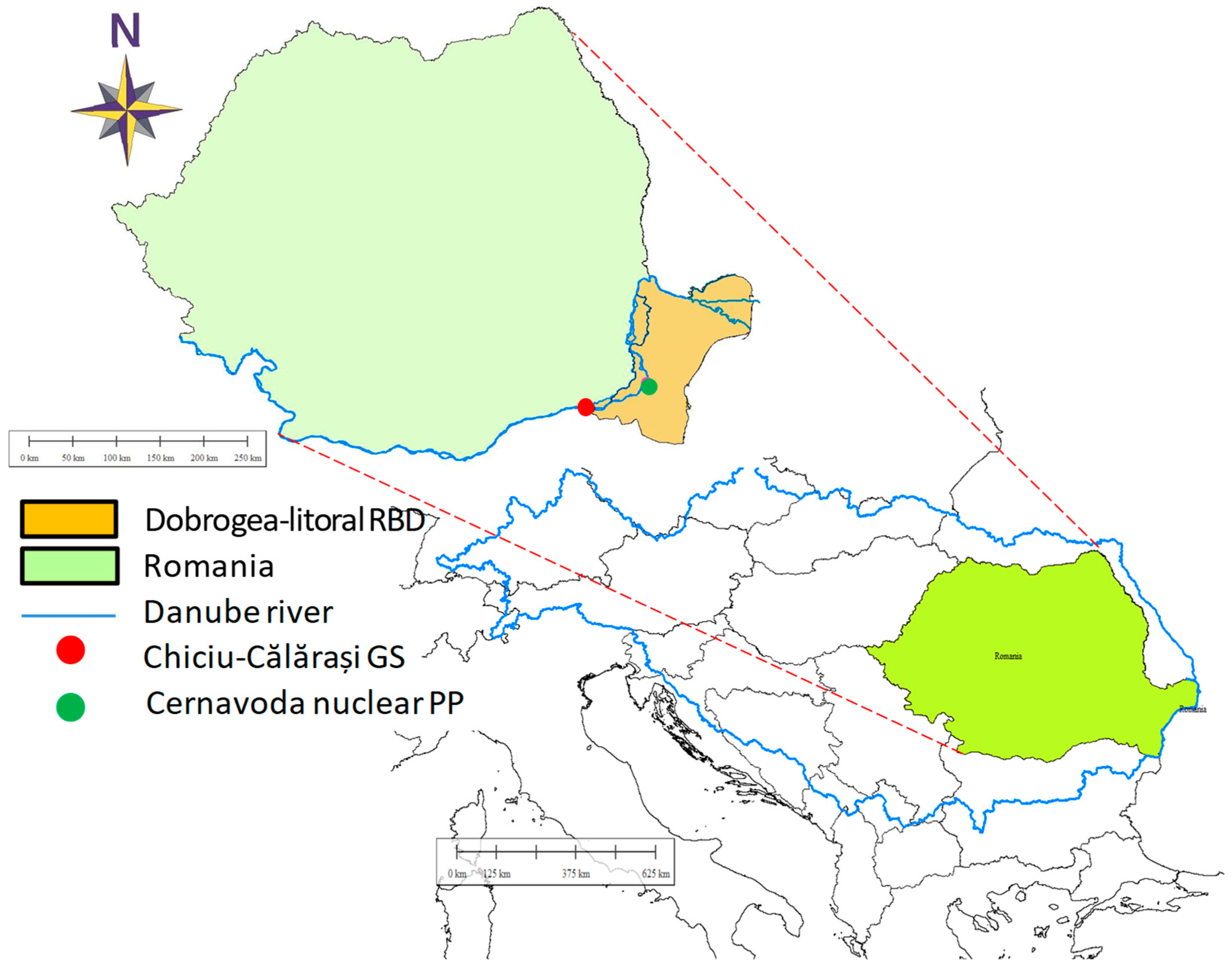

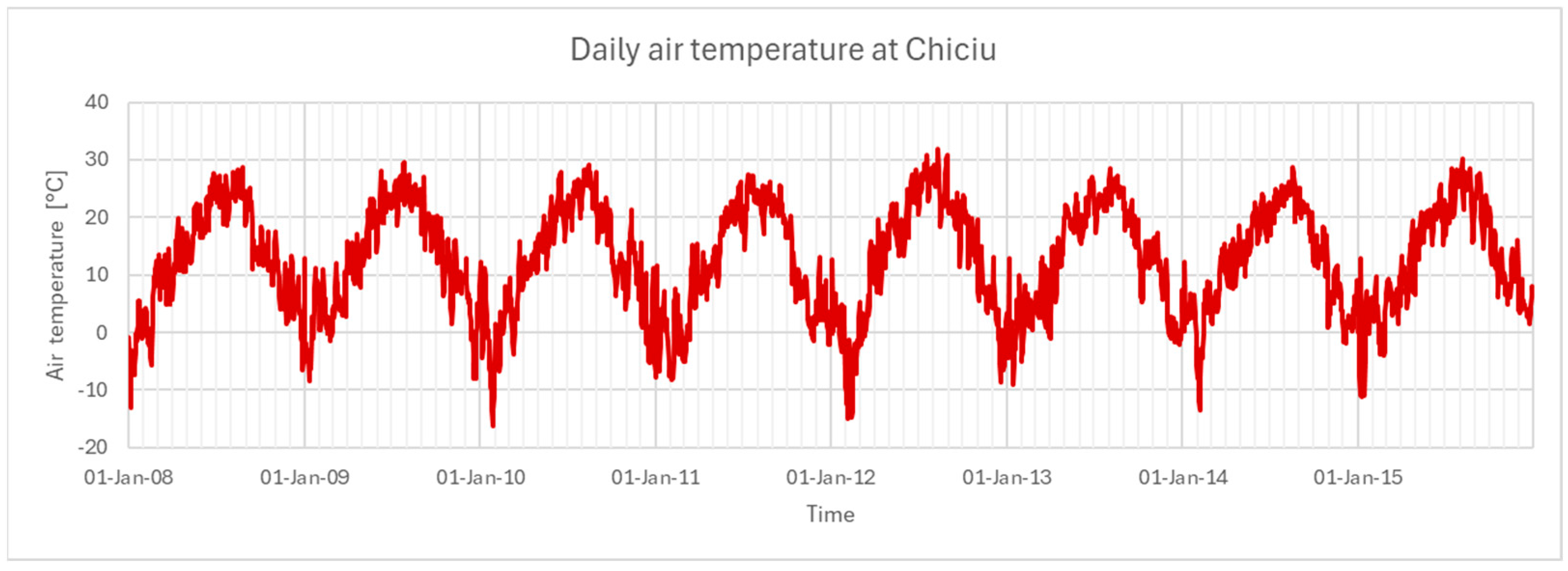
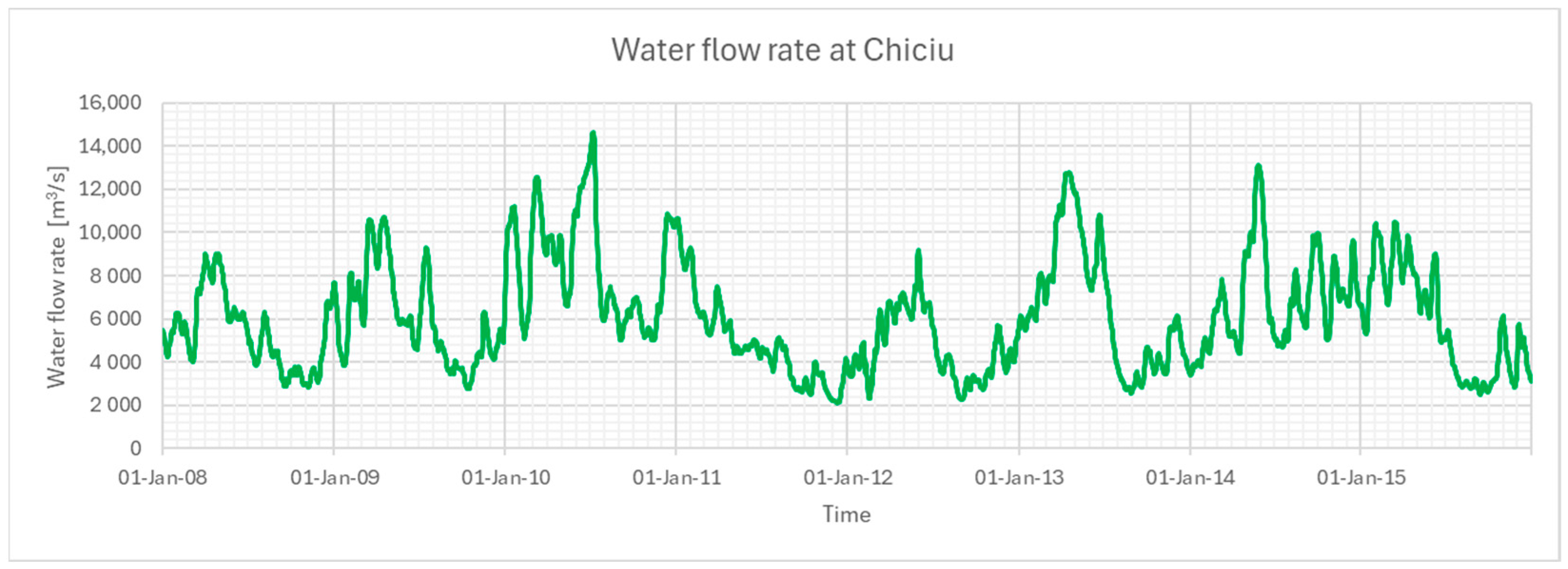


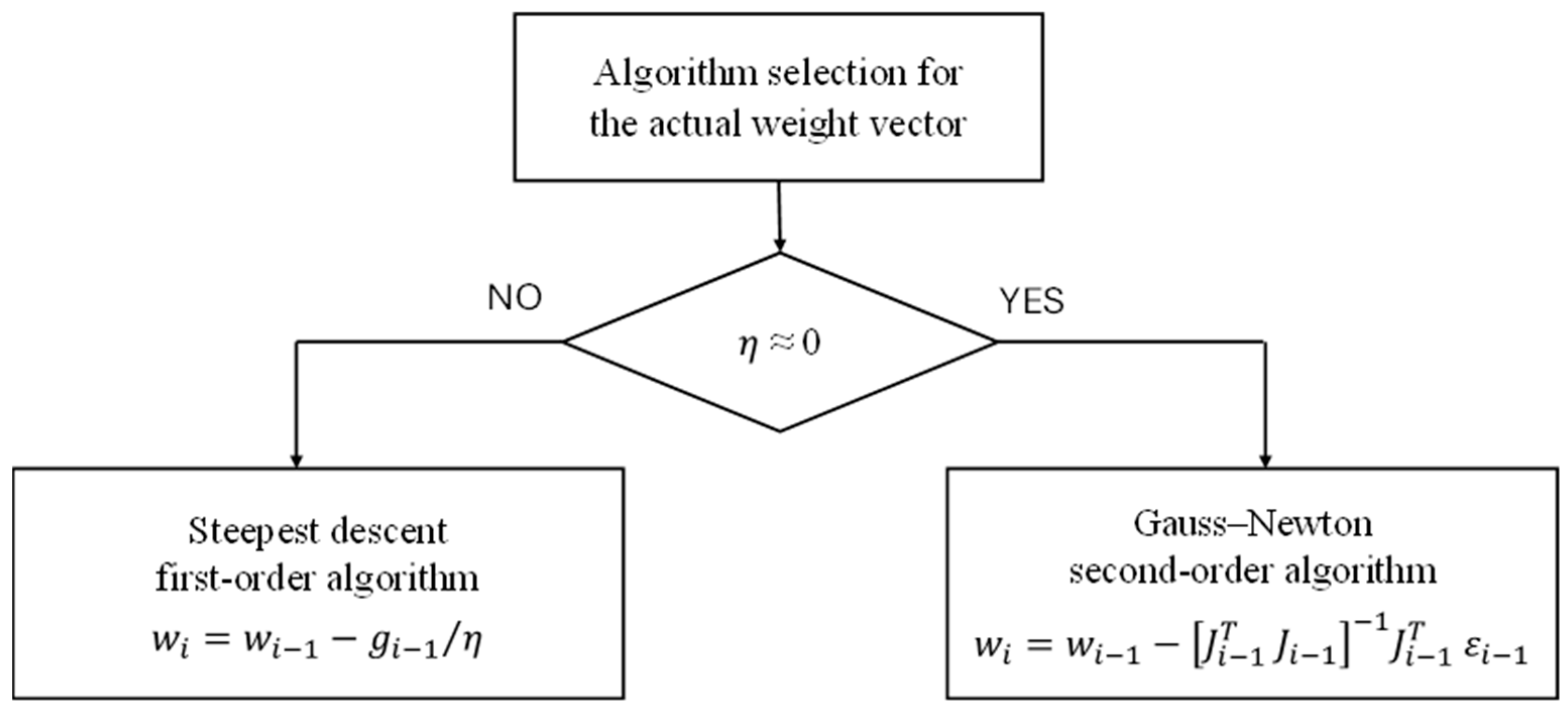
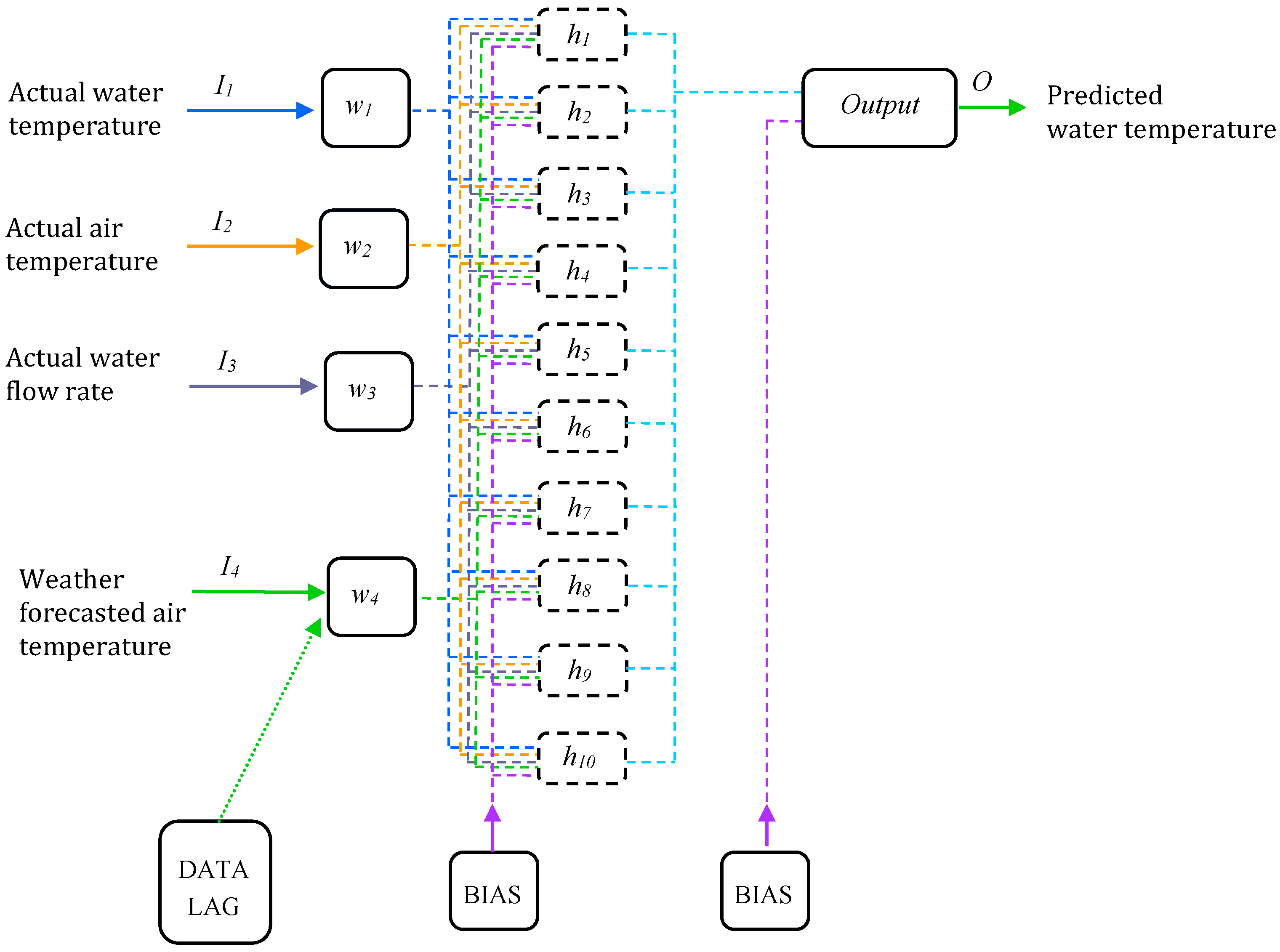
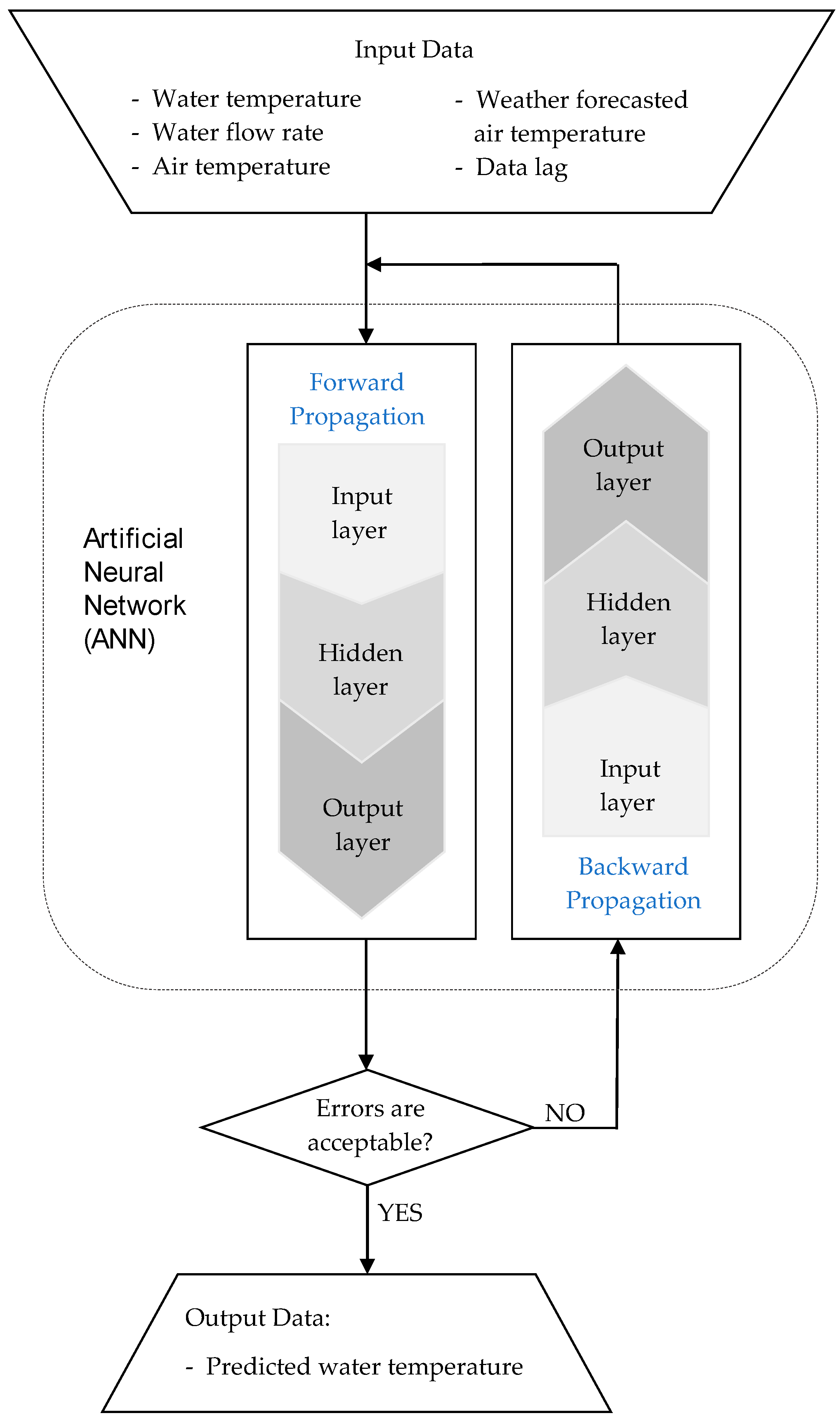
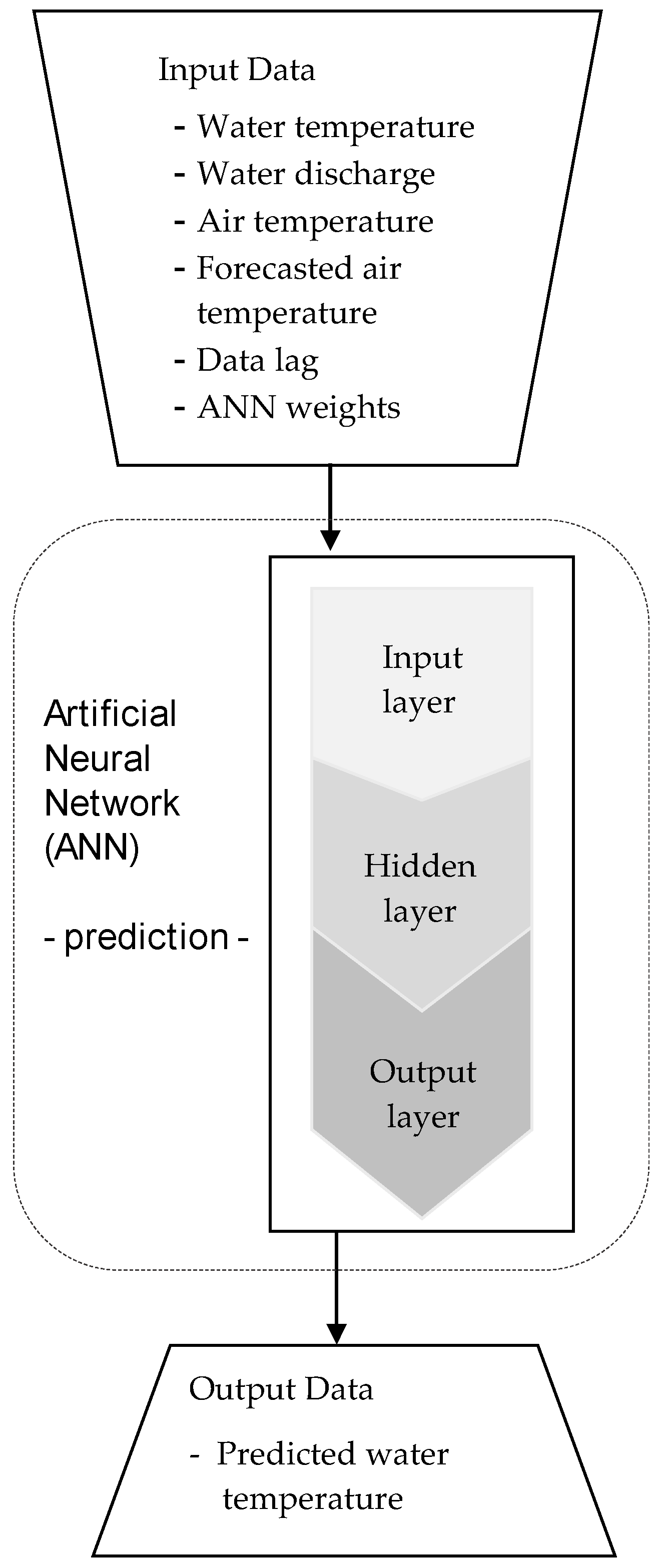
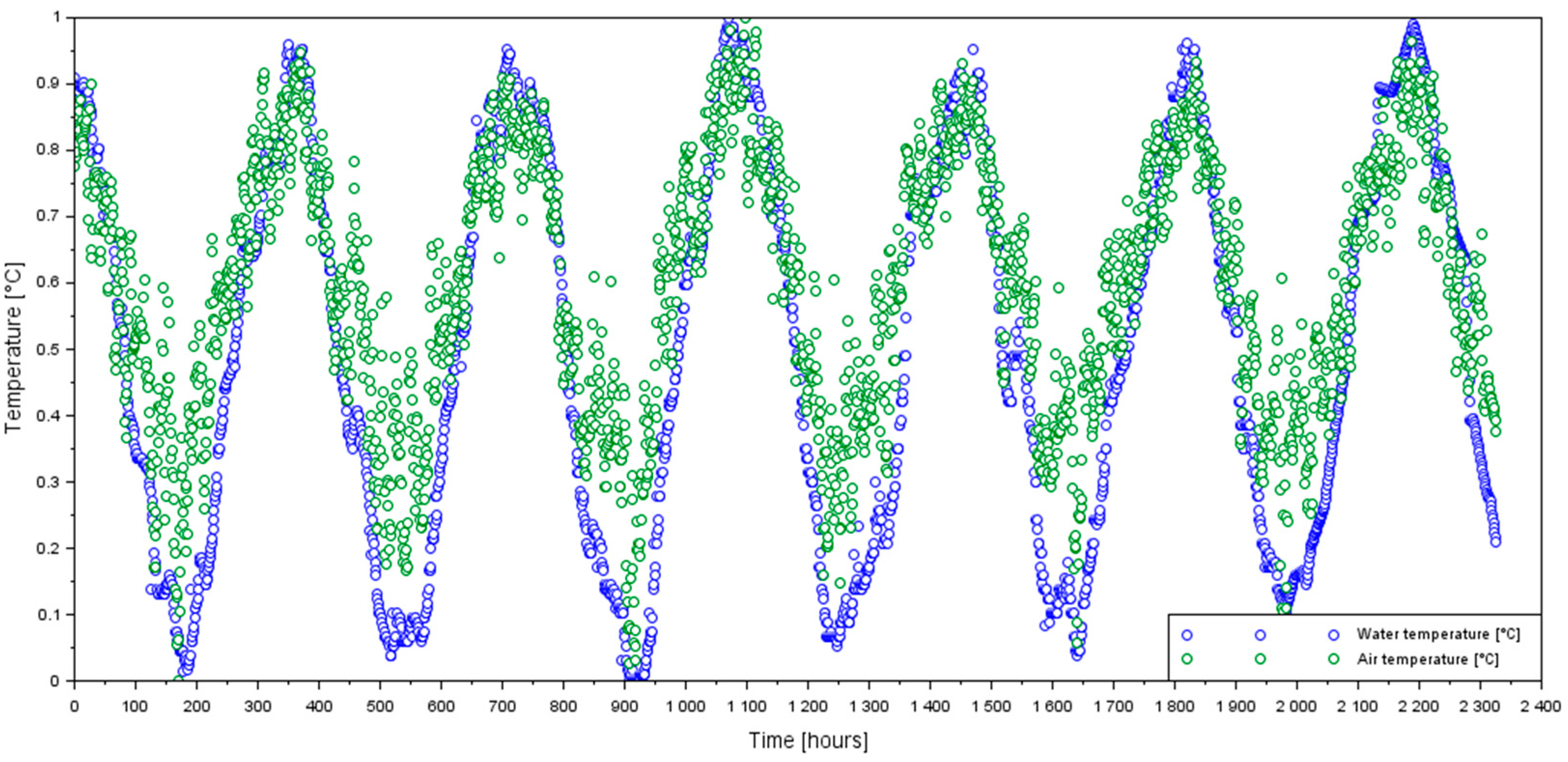
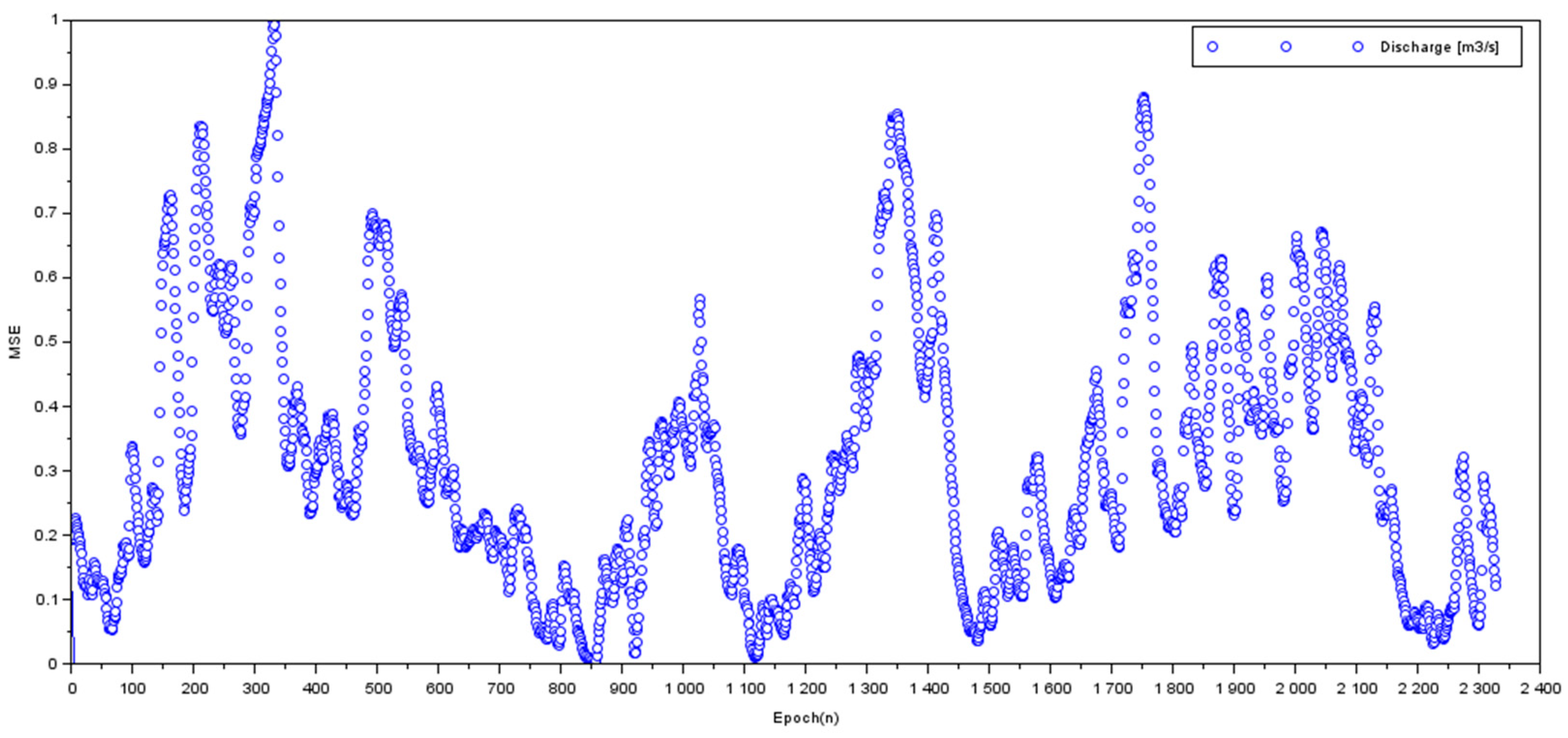


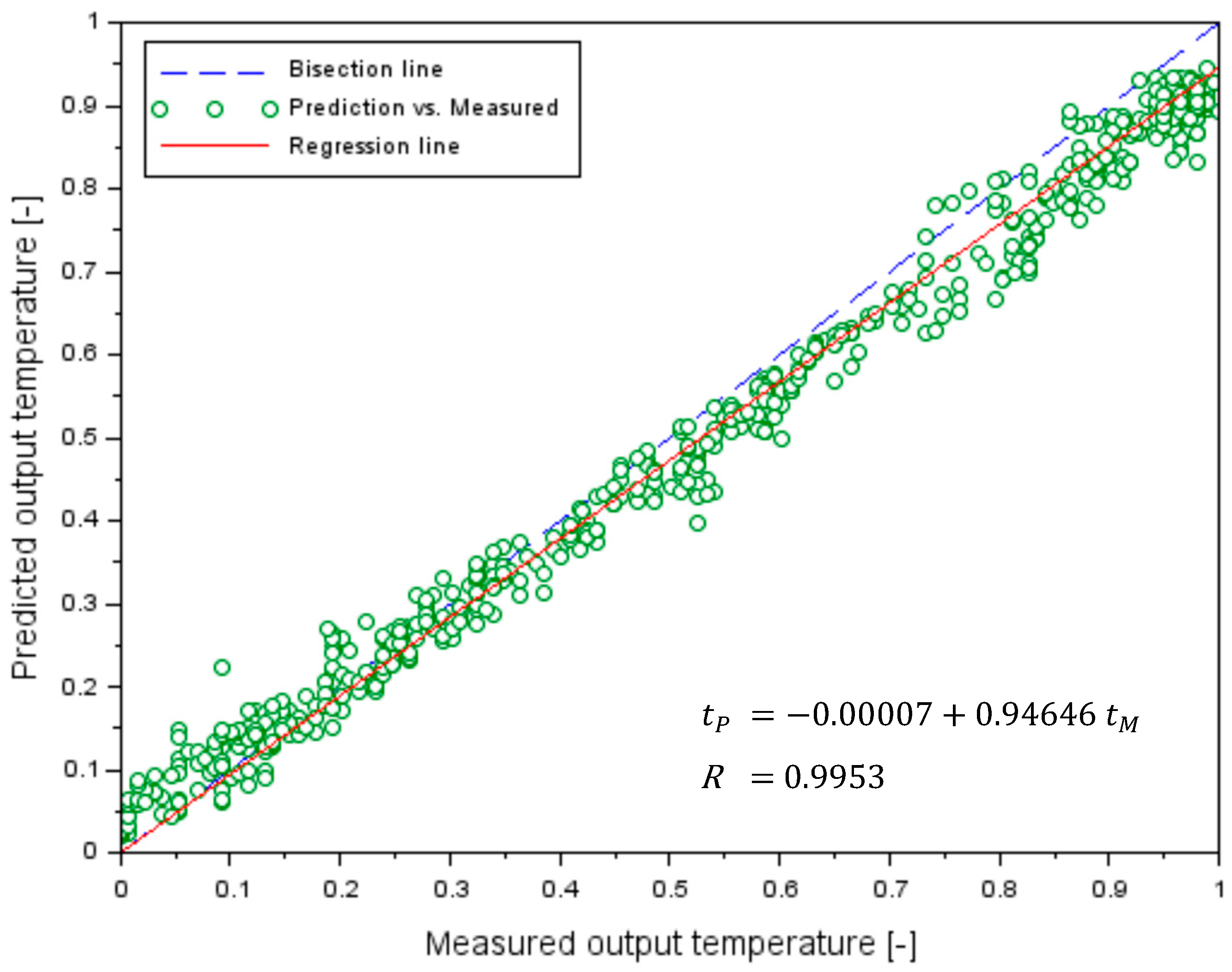
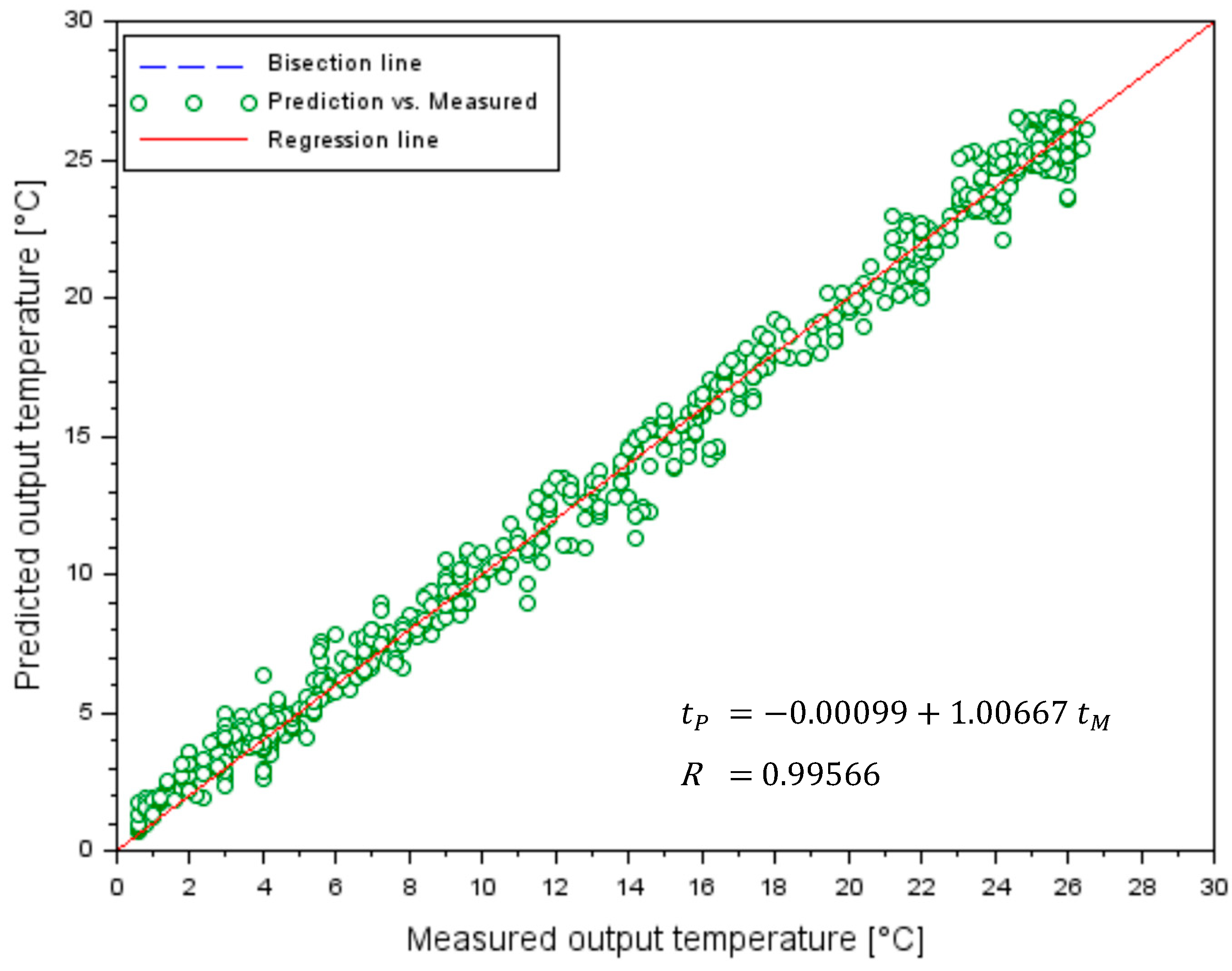
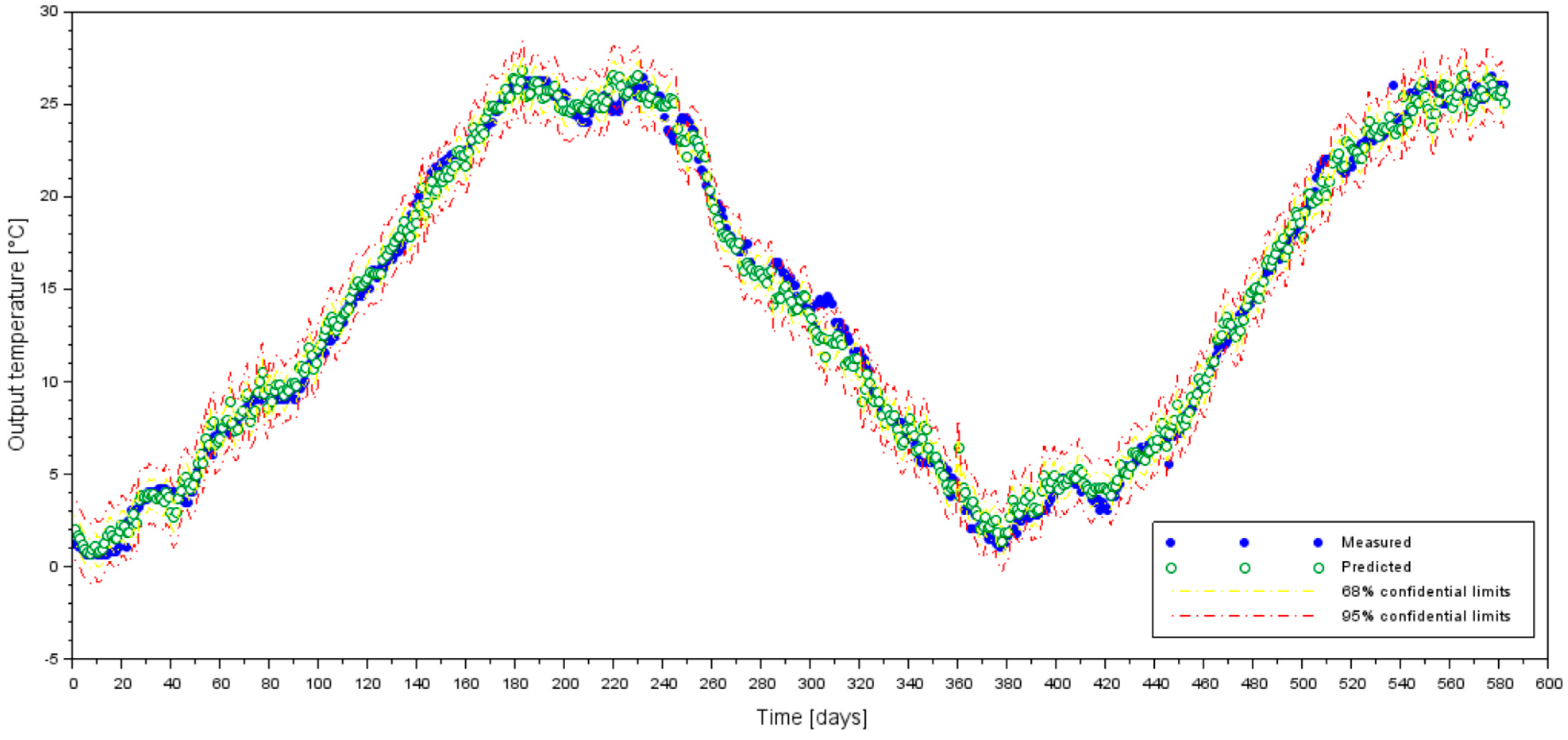
| Model | Predicted Water Temperature, in °C | R [-] | RMSE [°C] |
|---|---|---|---|
| ANN | 0.995 | 0.803 | |
| Model 1 | 0.989 | 1.288 | |
| Model 2 | 0.989 | 1.283 | |
| Model 3 | 0.578 | 13.159 | |
| Model 4 | 0.989 | 1.217 |
| Reference | Model | Training | Testing | ||
|---|---|---|---|---|---|
| R | RMSE [°C] | R | RMSE [°C] | ||
| [47] | WTAI 1 | 0.919–0.984 | 1.127–2.471 | 0.916–0.980 | 1.286–2.350 |
| [11] | LSTMTE 2 | 0.931 | 0.567 °C | 0.845 | 0.625 °C |
| [12] | FFNN 3 OPELM 4 AdaBoost 5 Bagging 6 | 0.938 0.937 0.939 0.941 | 2.634 2.655 2.618 2.580 | 0.941 0.942 0.941 0.939 | 2.605 2.583 2.615 2.660 |
| Danube River ANN model | LMFB 7 | 0.993 | 0.954 | 0.995 | 0.803 |
Disclaimer/Publisher’s Note: The statements, opinions and data contained in all publications are solely those of the individual author(s) and contributor(s) and not of MDPI and/or the editor(s). MDPI and/or the editor(s) disclaim responsibility for any injury to people or property resulting from any ideas, methods, instructions or products referred to in the content. |
© 2025 by the authors. Licensee MDPI, Basel, Switzerland. This article is an open access article distributed under the terms and conditions of the Creative Commons Attribution (CC BY) license (https://creativecommons.org/licenses/by/4.0/).
Share and Cite
Ionescu, C.-S.; Opriș, I.; Nistoran, D.-E.G.; Baciu, C.-A. Forecasting Model for Danube River Water Temperature Using Artificial Neural Networks. Hydrology 2025, 12, 21. https://doi.org/10.3390/hydrology12020021
Ionescu C-S, Opriș I, Nistoran D-EG, Baciu C-A. Forecasting Model for Danube River Water Temperature Using Artificial Neural Networks. Hydrology. 2025; 12(2):21. https://doi.org/10.3390/hydrology12020021
Chicago/Turabian StyleIonescu, Cristina-Sorana, Ioana Opriș, Daniela-Elena Gogoașe Nistoran, and Constantin-Alexandru Baciu. 2025. "Forecasting Model for Danube River Water Temperature Using Artificial Neural Networks" Hydrology 12, no. 2: 21. https://doi.org/10.3390/hydrology12020021
APA StyleIonescu, C.-S., Opriș, I., Nistoran, D.-E. G., & Baciu, C.-A. (2025). Forecasting Model for Danube River Water Temperature Using Artificial Neural Networks. Hydrology, 12(2), 21. https://doi.org/10.3390/hydrology12020021






